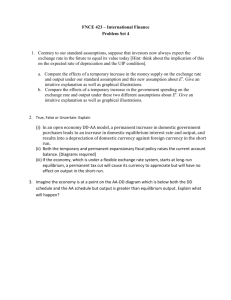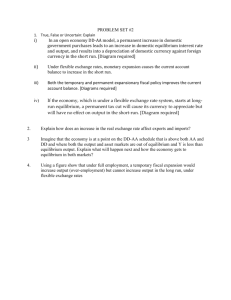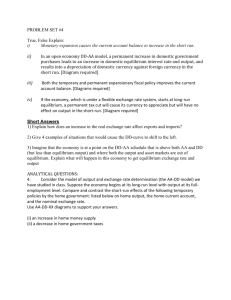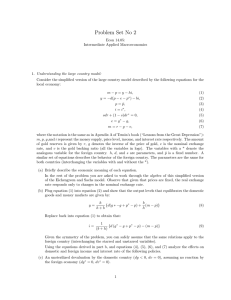Solutions Exam 1 14.05
advertisement
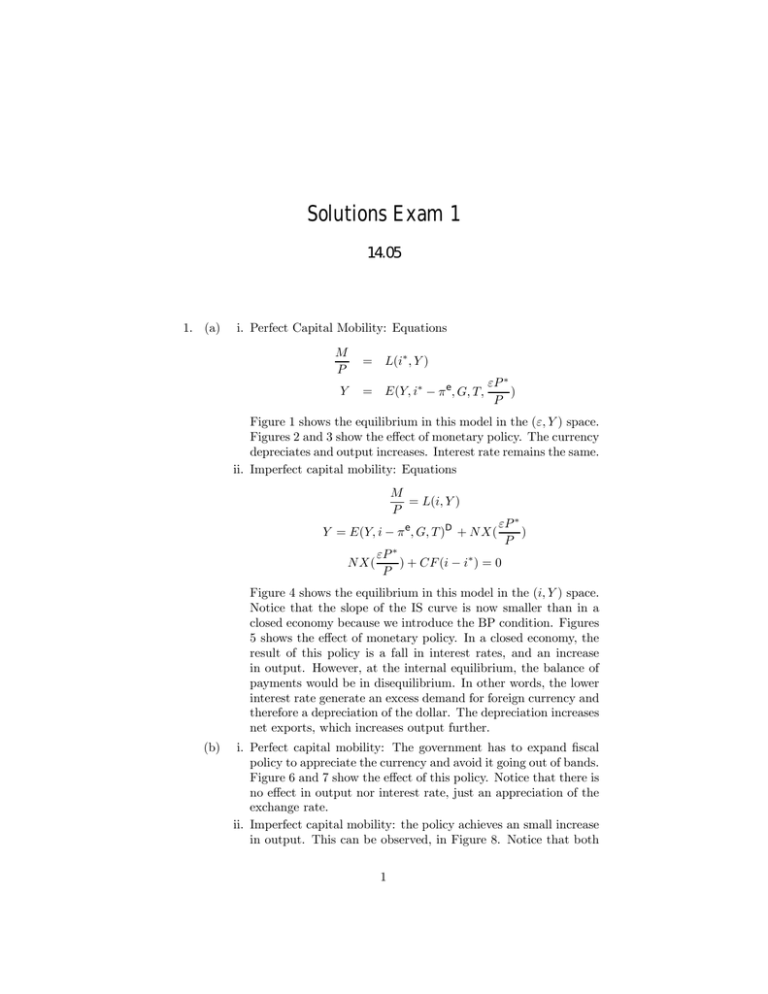
Solutions Exam 1 14.05 1. (a) i. Perfect Capital Mobility: Equations M P Y = L(i∗ , Y ) = E(Y, i∗ − π e , G, T, εP ∗ ) P Figure 1 shows the equilibrium in this model in the (ε, Y ) space. Figures 2 and 3 show the effect of monetary policy. The currency depreciates and output increases. Interest rate remains the same. ii. Imperfect capital mobility: Equations M = L(i, Y ) P Y = E(Y, i − π e , G, T )D + N X( N X( εP ∗ ) P εP ∗ ) + CF (i − i∗ ) = 0 P Figure 4 shows the equilibrium in this model in the (i, Y ) space. Notice that the slope of the IS curve is now smaller than in a closed economy because we introduce the BP condition. Figures 5 shows the effect of monetary policy. In a closed economy, the result of this policy is a fall in interest rates, and an increase in output. However, at the internal equilibrium, the balance of payments would be in disequilibrium. In other words, the lower interest rate generate an excess demand for foreign currency and therefore a depreciation of the dollar. The depreciation increases net exports, which increases output further. (b) i. Perfect capital mobility: The government has to expand Þscal policy to appreciate the currency and avoid it going out of bands. Figure 6 and 7 show the effect of this policy. Notice that there is no effect in output nor interest rate, just an appreciation of the exchange rate. ii. Imperfect capital mobility: the policy achieves an small increase in output. This can be observed, in Figure 8. Notice that both 1 LM ε IS Y Figure 1: ε LM 0 LM 1 ε1 ε0 IS 0 Y Figure 2: 2 LM0 LM1 i i* IS1 IS0 Y Figure 3: i LM 0 IS 0 Y Figure 4: 3 i LM0 LM1 E0 i0 * * i1 E1 IS1 IS0 Y Figure 5: ε LM 0 ε0 ε1 IS 0 Y Figure 6: 4 LM 0 i* IS 1 IS 0 Y Figure 7: output and interest rates increase. As CF increase we need net exports to decrease and thus the exchange rate appreciates but less than before. The reason is that the appreciation required to restore external equilibrium (BP=0) is smaller than under perfect capital mobility. (c) Notice that now NX= -b-CF. Replacing that in the IS curve we have Y = E(Y, i − πe , G, T )D − CF (i − i∗ ) − b. This implies that for all level of i, Y is going to be smaller, i.e. the IS curve shifts to the left. See Figure 9. (d) Thus both interest rate and output fall. The intervention, in which the central bank buys domestic currency, causes the domestic currency to appreciate. The fact that the IS curve shifts to the left tells us that output is smaller for a given price. Thus, the AD curve is also shifting to the left and in equilibrium we have a lower price level. (e) You are basically asked to discuss overshooting in this part. In particular, assume that the IS curve does not adjust immediately. Then as a consequence of expansive monetary policy we have a depreciation (we know that from part 1) and a decrease in the interest rate. See Figure 10. Notice that now we are using the fact that the IS curve does not adjust immediately. What happens in the long run? We know, because of long run neutrality of money, that in the long run prices and exchange rate both increase 1 to 1 with the increase in the quantity of money. So, there is a depreciation in the long run. And as we just argued, there is a depreciation also in the short run. 5 i LM E1 E0 IS1 IS0 Y Figure 8: LM0 i IS0 IS1 Y Figure 9: 6 LM0 i IS0 IS1 Y Figure 10: Which one is bigger? Do we jump to the long run value from the beginning? No. The reason is that now i < i∗ . Thus if we jump today to the long run value for the exchange rate then there is no expected change on the exchange rate and capital leaves the country. But if capital is leaving the country, there is less demand for the domestic currency and the currency depreciates. So this can’t be an equilibrium. The same reasoning applies for a smaller devaluation in the short run. For capital to stay here we need to compensate for the fact that the interest rate is smaller. And according to the UIP i = i∗ + E(úε/ε) ⇔ E(úε/ε) = i − i∗ < 0, which implies that investors should be expecting an appreciation all the way to the long run in order for the capital to stay. And the only way this can happen is if the currency devaluates today more than in the future!!!! 2. Bejamin Strong’s fears: (a) The effect of abandoning the gold standard (Þxed exchange rate), ßoating the exchange rate and increasing the money supply is a depreciation of the currency and an increase in output. Both effect can be observed in Figure 11. The exchange rate increases from ε0 to ε1 and output increases from Y0 to Y1 . As in this part of the question we are assuming small country, the interest rate remains unaffected. (b) All the countries are identical, therefore we have to relax the small economy assumption and consider the effect of one country’s policies 7 LM ε IS0 e1 e0 Y0 Y1 Y Figure 11: on the other. In particular, it is important to realize that if all the countries are devaluing their currency by the same amount, then the exchange rates, which represent the price of one currency interms of the other, remain the same. This is equivalent to the simultaneous devaluation case that you studied in the large economy model. Now, to determine what happens to output we only have to realize that the expansion obtained in part (a) has 2 components. The Þrst is the direct effect of the increase in money supply, which increases output along the IS. The second is the depreciation effect which shifts the IS. In this case we have the money supply effect, but not the depreciation effect. Therefore, the increase in output has to be smaller. The situation is depicted in Figure 12. (c) The hint is telling us that after the second country devalues, the situation is going to be like in part (b): output is going to be smaller than in part (a), but it is still going to be higher than before any country devalued. Putting both results together we have that before the rest of the world follows, ouput is going to increase as much as in (a), however, after the rest of the world devalues, output is going to fall to the level obtained in (b). In summary, the country we are analyzing is going to have a large expansion in output followed by small contraction. Something similaris going to happen to the exchange rate, it will depreciate after the initial move (to the level 8 IS0 LM ε IS1 e0 Y0 Y2 Y1 Y Figure 12: ε1 ), but it will return to its original value after the rest of the world follows (to the level ε0 ). The situation is presented in Figure 13. (d) What is happening here is that the pattern of expansion-contraction observed in part (c) is going to repeat indeÞnitely. Under this circumstances, both, exchange rate and output will follow a seesaw trayectory in time. The trayectory of exchange rate is presented in Figure 14. The trayectory of output is analogous. (e) In this case you have to realize that all the analysis we are making is on the side of aggregate demand. So far we have implicitly assumed that aggregate supply remains Þxed (Þx prices). Now, when we want to analyze price ßuctuations, we have to put ourselves in a situation in which the aggregate demand is upward sloping. Under this assumption, the shifts in output that we have determined do not correspond to the real equilibrium, but to shifts on the aggregate demand. Every time the local country expands the money supply, aggregate demands shifts outwards. Every time the rest of the world follows, aggregate demands contracts a little, but less than it initial expansion. Therefore, this kind of policiy keeps pushing the aggregate demand outwards indeÞnitely. It is as if aggregate demand took two steps forward and one step back each time. At the end of the day, prices are going to follow an increasing pattern (because prices will lie on the AS curve). The pattern is depicted in Figure 15. 9 IS0 LM ε IS1 e0 e0 Y0 Y2 Y1 Y Figure 13: ε e1 e0 t Figure 14: 10 P t Figure 15: 3. Labor Markets (a) Deßation will create unemployment only if nominal wages are rigid, so they do not adjust to the fall in prices, and the real wage keeps rising as a consequence. Assuming that the economy is initial in its competitive equilibrium, and that nominal wages are Þx, the fall in prices will keep increasing the real wage, and generating a gap between the amount of labor that workers are willing to supply and the amount of labor Þrms are willing to hire at the current real wage. The situation is presented in Figure 16. (b) One of the important Þndings in Nickell’s article is that countries that follow aggresive pro-employment policies, in which there are strong incentives for workers to go back to work and active help in reallocation by part of the government, are those which have achieved larger reductions in the unemployment rate. The measures that Peter Hartz is proposing are consistent with this Þndings, and to the extent that the evidence reported in Nickell’s article is correct, we would expect that these measures would achive a reduction in unemployment rates. (c) A minimum wage legislation may or may not have effect in unemployment. If the minimum wage is set below the equilibrium level, it will be no binding, and it will not induce unemployment. However, if the minimum wage is set above the market clearing level, it will be binding and generate unemployment. The situation is presented in 11 w/P Ls w0/P1 w0/P0 L1 L0 L1s L Figure 16: Figure 17. (d) If unions keep gaining strength, and they become important in the wage bargaining process, the right kind of model to understand the labor market is one of insiders-outsiders. We know that under the assumptions of this model, which would be closely matched by reality, the bargaining process creates a quai-labor supply, which is upward sloping but is located to the left of the real labor supply. Therefore, starting from an equilibrium on the labor supply and no unemployment, the increasing power of the unions will induce a positive amount of unemployment as depicted in Figure 18. (e) In order to generate a procyclical wage, equilibrium on the labor market cannot be on the labor demand. The reason is that the labor demand is downward sloping, so real wages have to fall in order to increase output. Any of the other two models, in which equilibrium is always on the labor supply or quasi-labor supply is consistent with the evidence. U.S. data seems more consistent with a model of wage ßexibility and imperfect competition on the product market. The case of ßexible wages, and imperfect competition is presented in Figure 19. 12 w/P U Ls (w/P)1 (w/P)0 Ld L Figure 17: w/P w(L) Ls (w/P)1 (w/P)0 Ld U Figure 18: 13 L w/P Ls (w/P)1 (w/P)0 Ld L Figure 19: 14
